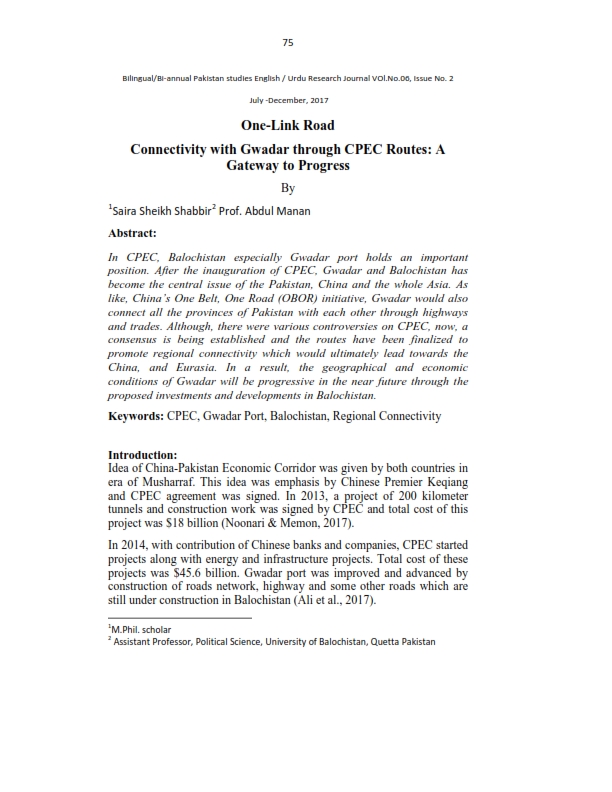One link road Connectivity with Gwadar through CPEC Routes A Gateway to Progress
Keywords:
CPEC, Gwadar Port, Balochistan, Regional ConnectivityAbstract
In CPEC, Balochistan especially Gwadar port holds an important
position. After the inauguration of CPEC, Gwadar and Balochistan has
become the central issue of the Pakistan, China and the whole Asia. As
like, China’s One Belt, One Road (OBOR) initiative, Gwadar would also
connect all the provinces of Pakistan with each other through highways
and trades. Although, there were various controversies on CPEC, now, a
consensus is being established and the routes have been finalized to
promote regional connectivity which would ultimately lead towards the
China, and Eurasia. In a result, the geographical and economic
conditions of Gwadar will be progressive in the near future through the
proposed investments and developments in Balochistan
References
Abid, M., & Ashfaq, A. (2015). CPEC: Challenges and opportunities for
Pakistan. Journal of Pakistan Vision, 16(2), 142-169.
Ahmar, D. (2015). ,“Strategic Meaning of the China-Pakistan Economic
Corridor”. Institute of Strategic Studies Islamabad2014 and, 39.
Ali, L., Mi, J., Shah, M., Shah, S. J., Khan, S., & BiBi, K. (2017). The Potential
Socio-Economic Impact of China Pakistan Economic Corridor.
Asian Development Policy Review, 5(4), 191-198.
Anwar, S., Khan, M. A., & Sarwar, A. (2017). Minhas Majeed Khan, et al
(eds.). China-Pakistan Economic Corridor--A Game Changer.
Pakistan Development Review, 56(1), 79-83.
Chaudhry, F. (2014). The Political Economy of Energy in Pakistan:
Perspectives from Balochistan's Natural Gas Fields and the Port
City of Gwadar GLOBALIZATION, DEVELOPMENT AND SECURITY IN
ASIA: The Political Economy of Energy (pp. 133-155).
Chaziza, M. (2016). China–Pakistan Relationship: A Game-changer for the
Middle East? Contemporary Review of the Middle East, 3(2), 147-
Hali, S. M., Yong, S. I. D. W., & Kamran, S. M. (2017). Impact of Energy
Sources and the Electricity Crisis on the Economic Growth: Policy
Implications for Pakistan. JETP, 7(2).
Hassan, A. (2005). Pakistan's Gwadar port prospects of economic revival.
Monterey, California. Naval Postgraduate School.
Hussain, F., & Hussain, M. (2017). China-Pak Economic Corridor (CPEC)
and Its Geopolitical Paradigms. International Journal of Social
Sciences, Humanities and Education, 1(2), 89-105.
Hussain, M. (2017). China Pakistan Economic Corridor (CPEC): Challenges
and the way forward. Monterey, California: Naval Postgraduate
School.
Irshad, M. S. (2015). One Belt and One Road: Dose China-Pakistan
Economic Corridor Benefit for Pakistan's Economy?
Javaid, U., & Jahangir, A. (2015). Pakistan-China Strategic Relationship: A
Glorious Journey of 55 Years. Journal of the Research Society of
Pakistan, 52(1).
Mehmood, M. (n. d.) China-Pakistan economic Corridor-The GeoStrategic Dimension and Challenges. CISS Insight: Quartely News
& Views.
Muzalevsky, R. (2014). Central Asia's Shrinking Connectivity Gap:
Implications for US Strategy: ARMY WAR COLLEGE CARLISLE
BARRACKS PA STRATEGIC STUDIES INSTITUTE.
Noonari, I. A., & Memon, A. P. (2017). Pakistan-China Cooperation And Its
Impact On South Asia. The Government-Annual Research Journal
of Political Science., 5(5).
Rahman, S., & Shurong, Z. (2017). Analysis of Chinese Economic and
National Security Interests in China-Pakistan Economic Corridor
(CPEC) under the Framework of One Belt One Road (OBOR)
Initiative. Arts Social Sci J, 8(284), 2.
Sial, S. (2014). The China-Pakistan Economic Corridor: an assessment of
potential threats and constraints. Conflict and Peace Studies, 6(2),
Tong, L. (2015). CPEC Industrial Zones and China-Pakistan Capacity
Cooperation. Strategic Studies Journal, 35(1), 174-184.



